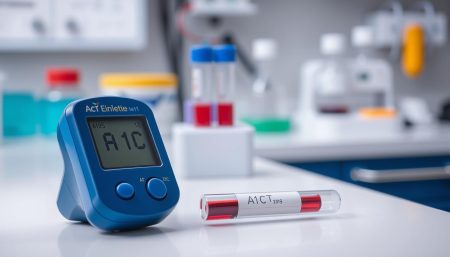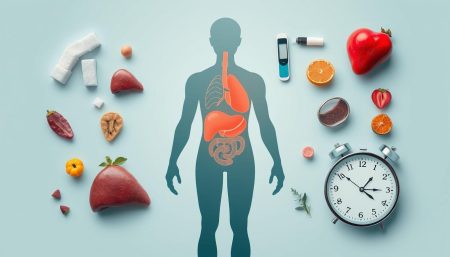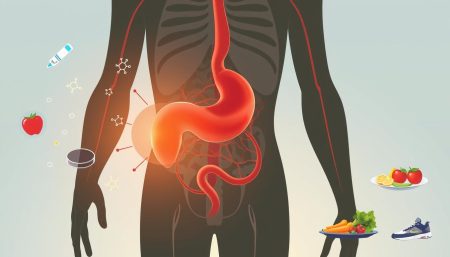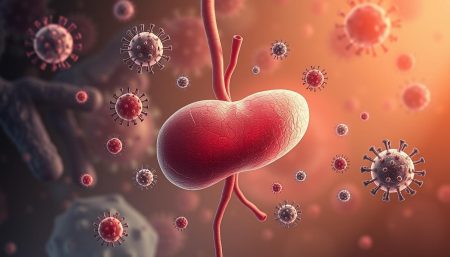Understanding type 1 diabetes mellitus is key to managing this complex condition. It affects many, often starting in childhood or early adulthood. It’s an autoimmune disease that attacks and destroys pancreatic beta cells, stopping insulin production and requiring lifelong hormone replacement.
This deep dive into T1DM management explores causes and how to manage it. It looks at the role of genetics and the environment. Spotting symptoms early is vital to prevent high blood sugar levels.
Managing diabetes type 1 involves more than one approach. It includes insulin therapy, careful diet, exercise, and mental health support. It aims to improve daily life for those with T1DM, helping them overcome the challenges.
Understanding Type I Diabetes Mellitus
Type I Diabetes Mellitus (T1DM) is an autoimmune diabetes. It’s a specific type of diabetes. The body’s immune system attacks the insulin-making cells in the pancreas, causing a lack of insulin.
T1DM usually starts early in life, making it known as juvenile diabetes. It comes on quickly and symptoms are severe. This is why it’s called insulin-dependent diabetes and needs constant insulin treatment.
Defining Type I Diabetes Mellitus
This diabetes type is ongoing and lifelong. The body can’t make enough insulin, which is key for controlling blood sugar. Without insulin, people with T1DM face serious health issues from high blood sugar.
Distinction from Other Diabetes Forms
Type I Diabetes is different from Type 2 and gestational diabetes. Unlike Type 2, which is linked to lifestyle and obesity, T1DM is not. Here’s a quick comparison of the main differences:
| Type of Diabetes | Primary Cause | Common Age of Onset | Dependency on Insulin |
|---|---|---|---|
| Type I Diabetes (T1DM) | Autoimmune reaction | Childhood/Adolescence | Yes – Lifelong |
| Type 2 Diabetes | Lifestyle factors, genetics | Adults | Not initially required |
| Gestational Diabetes | Hormonal changes during pregnancy | During pregnancy | May be required |
It’s important to understand T1DM’s unique aspects and how to manage them. This helps in treating the disease and improving life quality for those with juvenile diabetes. Each person with diabetes needs a personalized plan to manage blood sugar, diet, and exercise.
The Epidemiology of Type 1 Diabetes
The world is seeing more cases of type 1 diabetes, which is a big deal for kids’ health. Knowing how this disease spreads is key to helping kids live healthier lives.
Studies show that where you live can affect if you get type 1 diabetes. This is because of genes and the environment. So, we need special plans for different places to help manage diabetes.
- North America and Europe have the most cases of type 1 diabetes. The numbers have gone up over the past 20 years.
- Low and middle-income countries have fewer reported cases. But, there are more cases that haven’t been found yet.
- Some ethnic groups are more likely to get diabetes in children. This is true even when they live in the same place.
More kids are getting type 1 diabetes, so we need to find better ways to catch it early. We also want to stop it from happening in the first place by changing how kids live.
Learning about type 1 diabetes helps us make better health programs for kids. We want to stop the number of kids with diabetes from growing.
The Autoimmune Nature of Type One Diabetes
Exploring autoimmune diabetes helps us understand why the body attacks its own cells. In Type 1 Diabetes Mellitus (T1DM), the immune system mistakenly destroys pancreatic beta cells. These cells are key for insulin production.
The immune system’s wrong attack on these cells leads to their failure and death. This is why people with Type 1 diabetes need insulin their whole lives.
Looking closer, we see that genetics and environment might play a part. But the main issue is the immune system’s wrong attack on insulin-making cells.
Knowing about this autoimmune part is key to managing T1DM well. It helps find ways to prevent diabetes-related hair loss. Insulin balance and immune health are closely connected.
| Autoimmune Marker | Role in T1DM | Impact on Pancreatic Cells |
|---|---|---|
| Islet Cell Antibodies (ICA) | Early marker of autoimmune activity | Directly targets and damages beta cells |
| Insulin Autoantibodies (IAA) | Often found at or before T1DM onset | Contributes to the immune-mediated destruction |
| Glutamic Acid Decarboxylase Antibodies (GADA) | Common in T1DM diagnosis | Attacks enzyme in beta cells, impairing function |
In summary, understanding T1DM causes from an autoimmune angle is vital. It leads to better, more tailored treatments. This knowledge is essential for doctors and patients to manage Type 1 Diabetes Mellitus effectively.
Genetic Factors Contributing to Diabetes Type 1
Genetics play a big role in Type 1 diabetes. It involves many hereditary and genetic factors. Knowing these helps find people at risk and prevent the disease.
Hereditary Risks and Family History
Studies show that those with a family history of Type 1 diabetes are more likely to get it. This shows how important hereditary diabetes is. For example, siblings and kids of people with Type 1 diabetes are at higher risk because of shared genes.
Genetic Markers and Predisposition
The Human Leukocyte Antigen (HLA) complex is key in genetic predisposition to diabetes. It greatly affects the risk of getting Type 1 diabetes. This genetic information helps us understand how genes and environment work together to cause the disease.
| Genetic Marker | Risk Increase for Type 1 Diabetes |
|---|---|
| HLA-DR3 or DR4 | Approximately 2 to 5 fold |
| Both HLA-DR3 and DR4 | Approximately 3 to 15 fold |
| Other Gene Combinations | Varied, lesser known impact |
Environmental Triggers for Type I Diabetes Mellitus
Looking into environmental factors T1DM helps us understand how outside factors can affect Type 1 Diabetes. Studies show that some viruses and early diet can trigger this disease. This is true for kids who are more likely to get it.
Viral Infections as Possible Triggers
Research shows that viruses can start an autoimmune reaction. This can lead to Type 1 Diabetes in people who are already at risk. It’s key to watch for and treat viral infections early in kids to prevent this disease.
Diet and Early Childhood Exposures
The food a child eats early on can greatly affect their risk of getting Type 1 Diabetes. Early exposure diabetes studies show that certain foods can mess with the immune system. This can cause the body to attack its own pancreatic cells.

| Trigger Type | Possible Influence | Preventive Measures |
|---|---|---|
| Viral Infections | Can activate autoimmune processes | Enhanced hygienic practices and timely vaccination |
| Dietary Patterns | May affect gut microbiome and immune system | Regulated early diet, avoidance of allergenic and processed foods |
Symptoms and Early Diagnosis of Type One Diabetes
It’s important to spot the early signs of Type 1 diabetes mellitus (T1DM) for quick diabetes diagnosis and care. The first T1DM symptoms might seem small but get worse over time. This means you should see a doctor right away.
- Excessive Thirst and Frequent Urination: Feeling very thirsty and needing to pee a lot are key signs of T1DM. This happens because your body tries to get rid of too much sugar.
- Unintentional Weight Loss: Even if you eat a lot, you might lose weight. This is because your body can’t use glucose well.
- Severe Fatigue: You might feel very tired because your cells don’t get enough glucose.
- Blurry Vision: High blood sugar can pull fluid from your eyes. This makes it hard to focus.
Spotting these symptoms is key for a diabetes diagnosis and to avoid serious problems. Catching T1DM early and getting medical help can change how the disease progresses. If you notice these signs, see a doctor fast. This can lead to quick testing and treatment, helping manage the condition well.
Crucial Blood Tests to Identify T1DM
To manage and diagnose Type 1 Diabetes Mellitus (T1DM), several key blood tests are used. These tests help understand how the body handles glucose. The A1C test, fasting blood sugar test, and random blood sugar test are vital for detecting and managing T1DM.
Glycated Hemoglobin (A1C) Test
The A1C test is key for tracking long-term glucose control. It shows the average blood glucose level over two to three months. An A1C level of 6.5% or higher suggests diabetes. To confirm T1DM, repeated tests are needed.
Fasting Blood Sugar Test
This test measures glucose after an overnight fast. It’s accurate if you haven’t eaten for at least eight hours. A reading of 126 mg/dL or higher on two tests usually means diabetes.
Random Blood Sugar Test
A random blood sugar test doesn’t need fasting and can be done anytime. It’s used when diabetes symptoms are severe. A level of 200 mg/dL or higher suggests diabetes, with symptoms of high blood sugar.
Knowing about these tests and their roles is key to early detection and managing Type 1 Diabetes Mellitus. Regular glucose testing is essential. It helps make quick changes to treatment plans based on glucose level changes.
Insulin Therapy: The Keystone of T1DM Management
Insulin therapy for diabetes is a must for those with managing diabetes type 1. Without insulin, the body can’t control blood sugar. We’ll look at the different types of insulin, how they’re given, and how they meet individual needs.
Finding the right insulin and how to take it is key to insulin therapy for diabetes. It’s about balancing insulin with meals, carbs, and activities. This balance can improve life quality and prevent serious diabetes complications.
- Rapid-acting insulin for mealtime blood sugar control
- Long-acting insulin to ensure blood sugar stability overnight or throughout the day
- Intermediate options that bridge the gap between rapid and long-acting insulin needs
Also, new tech like insulin pumps and continuous glucose monitors (CGMs) help manage managing diabetes type 1 better.
| Type of Insulin | Onset | Peak | Duration |
|---|---|---|---|
| Rapid-acting | 15 minutes | 1 hour | 3-4 hours |
| Short-acting | 30 minutes | 2-3 hours | 3-6 hours |
| Intermediate-acting | 1-2 hours | 4-8 hours | 12-18 hours |
| Long-acting | 1 hour | None | Up to 24 hours |
Adding insulin therapy for diabetes to daily life needs planning. But it lets people live active, healthy lives with managing diabetes type 1. Personal care plans and regular doctor visits are key.
Dietary Considerations for Managing Diabetes Type 1
Managing Type 1 Diabetes Mellitus (T1DM) well depends on good diet choices. These choices help control blood sugar and prevent health problems. Key strategies include counting carbs, eating high-fiber foods, and choosing low glycemic foods. Let’s explore why these are so important.
Carbohydrate Counting and Diabetes Management
Carb counting is key for diabetes management. It helps people with diabetes plan their meals and control blood sugar. By tracking carbs, they can adjust their insulin and keep their glucose levels right.
Importance of Dietary Fiber
Eating a high-fiber diet is vital for T1DM patients. Fiber slows down how quickly carbs are turned into glucose, preventing big blood sugar spikes. It also helps the heart by lowering cholesterol and reducing heart disease risk.
Glycemic Index: Choosing the Right Foods
Knowing the glycemic index (GI) helps control blood sugar. Foods with a GI of 55 or less, like whole oats and lentils, digest slowly. This means they cause a gradual increase in blood glucose. Adding these foods to your diet helps keep your glucose levels steady, which is key for managing diabetes.
| Food Category | Examples | Glycemic Index Range |
|---|---|---|
| Low GI Foods | Apples, lentils, barley | Below 55 |
| Medium GI Foods | Oatmeal, brown rice, sweet corn | 55-70 |
| High GI Foods | White bread, pretzels, popcorn | Above 70 |
Monitoring Blood Glucose Levels
Managing Type 1 Diabetes Mellitus well depends on careful blood glucose monitoring. This helps keep glucose control at its best. It involves using different devices that give real-time data. This data is key for adjusting insulin and what you eat.
The traditional glucose meter has long been a key tool in blood glucose monitoring. But, Continuous Glucose Monitors (CGMs) have changed the game. CGMs give constant feedback. This is vital for quick decisions to avoid blood sugar problems.
| Tool | Frequency of Monitoring | Data Provided |
|---|---|---|
| Traditional Glucose Meters | Multiple times daily | Instant glucose reading |
| Continuous Glucose Monitors (CGMs) | 24/7 Monitoring | Trends and real-time glucose levels |
CGMs let people adjust their lifestyle and insulin use for better glucose control. It’s important to understand how to read these data. Knowing how meals, exercise, and medicine affect blood sugar is key.
- Timing of Insulin: Administering insulin too early or late can impact blood sugar.
- Dietary Choices: Some foods can cause big spikes in blood sugar.
- Physical Activity: Exercise can quickly change blood sugar levels.
Keeping detailed records and spotting trends is critical for managing diabetes. By actively monitoring blood glucose, people with Type 1 Diabetes can improve their life. They can also avoid serious problems linked to poor glucose control.
Physical Activity: Balancing Exercise and Insulin
For those with Type 1 Diabetes Mellitus (T1DM), regular exercise is key. But, it’s important to know how it affects insulin levels. Finding the right balance can boost insulin sensitivity and improve health.
Exercise Recommendations for T1DM Patients
Various physical activities are beneficial for T1DM patients. Exercise not only boosts heart health but also insulin sensitivity, which is critical for glucose control. A mix of cardio like walking or cycling and strength training like weight lifting is advised.
It’s important to make exercise plans personal to fit each person’s health needs and insulin needs. Getting help from healthcare providers to adjust insulin doses for exercise is a safe step.
Understanding Insulin Sensitivity and Activity Levels
Exercise makes the body more responsive to insulin, needing less insulin to move sugar to cells. This effect can last up to 48 hours after exercise, affecting insulin needs. People with T1DM should watch their blood sugar closely before, during, and after exercise to avoid low blood sugar.
Insulin doses may need to be adjusted based on exercise intensity and length. Keeping a log of exercise and insulin changes can help understand personal patterns. This can lead to better glucose control during and after exercise.
Managing T1DM effectively involves a mix of exercise, insulin, and monitoring. Lifestyle plays a big role in managing the disease. Knowing how exercise impacts insulin use helps maintain balance and prevent blood sugar issues.
Advancements in Insulin Delivery Systems
The world of diabetes technology has changed a lot in recent years. Insulin pumps are leading this change. They make managing diabetes easier and help patients live better lives.
Today’s insulin pumps are easier to use. They have simple interfaces that help patients manage their diabetes well. They also work with continuous glucose monitors (CGMs) for real-time glucose tracking and automatic insulin delivery.
- Integration with Smart Technology: Modern insulin pumps connect easily with smartphone apps. This gives users detailed data to manage their diabetes better.
- Customizable Delivery Rates: These advanced devices let users adjust basal rates and bolus doses. This matches their unique daily needs.
- Increased Comfort and Discretion: Current models are smaller and can be worn discreetly. This makes managing diabetes less noticeable.
Diabetes technology has made insulin delivery better. It also gives users more control and flexibility. This makes it easier to keep blood sugar levels balanced all day.
| Feature | Benefits |
|---|---|
| Touchscreen Interface | Enhances user experience and simplifies management |
| Pre-set Mealtime Doses | Reduces the chances of dosage errors, improving safety |
| Remote Monitoring Capabilities | Allows healthcare providers to review patient data in real-time for better care |
| Water-resistant | Provides reliability and flexibility in various environments |
Innovations in insulin pumps and diabetes technology are exciting. They promise a future of more independent, precise, and less stressful diabetes management. These advancements not only improve insulin delivery but also enhance the lives of those with diabetes.
Preventing Complications of Type I Diabetes Mellitus
Managing Type I Diabetes Mellitus (T1DM) is more than just checking blood sugar. It’s about stopping diabetes complications before they start. Regular health checks are key to catching problems early and avoiding serious health issues.
Regular Check-Ups and Early Detection of Complications
Regular doctor visits are essential for spotting diabetes-related health problems early. These visits should include more than just blood sugar checks. They should also look at organs and systems often affected by diabetes, like the eyes, kidneys, and heart.
Managing Cardiovascular Health in T1DM
Diabetes and heart disease are closely linked. So, keeping your heart healthy is critical. Patients should eat well, exercise regularly, and not smoke. These habits help lower the risk of heart disease.
- Annual Heart Check-Up: Includes blood pressure monitoring, cholesterol profiles, and ECG tests.
- Dietary Consults: Regular meetings with a nutritionist to tailor diets that favor cardiovascular health.
- Exercise Plans: Custom exercise regimens that cater to individuals with T1DM, focusing on heart health.
| Health Parameter | Goal for Non-Diabetics | Adjusted Goal for T1DM Patients |
|---|---|---|
| Blood Pressure (mmHg) | < 120/80 | < 130/80 |
| LDL Cholesterol (mg/dL) | < 100 | < 70 |
| HbA1c (%) | 5.0 – 5.5% | < 7.0% |
Psychological Impact of Juvenile Diabetes
Diagnosing juvenile diabetes is tough on kids and teens. It’s not just physical; it hits their mental health hard too. It’s key to understand the emotional side and find ways to help manage mental health in diabetes.
Emotional Challenges and Mental Health Support
Kids with diabetes might feel anxious, depressed, or lonely. It’s vital to tackle these feelings with the right mental health care. Doctors should check for emotional issues often to help with mental health in diabetes.
Coping Strategies for Children and Adolescents
Helping kids cope with diabetes is important. Therapies like Cognitive Behavioral Therapy (CBT) can help. Also, joining support groups lets kids meet others who understand their struggles. This can help them feel less alone and learn from each other.
| Intervention | Description | Benefits |
|---|---|---|
| Cognitive Behavioral Therapy | Addresses negative thought patterns to improve emotional regulation. | Enhances coping skills, reduces stress, and improves overall well-being. |
| Peer Support Groups | Organized gatherings of peers dealing with similar health conditions. | Provides social support, decreases isolation, and increases disease management skills. |
Role of Support Groups in Diabetes Management
Diabetes support groups are key in managing Type 1 Diabetes Mellitus (T1DM). They offer a place to share experiences, learn from each other, and get emotional support. This support is essential for dealing with the daily struggles of diabetes.

Being part of T1DM community support groups can greatly improve life quality and disease management. Here are some benefits:
- Shared Experiences: Talking about daily challenges and solutions helps clear up diabetes management mysteries.
- Educational Resources: Members get info on new treatments, diet tips, and tech for T1DM.
- Emotional Support: Being with others who get the emotional side of T1DM makes you feel less alone.
- Motivation and Encouragement: Regular meetings boost motivation and create a supportive environment.
These diabetes support groups offer more than just practical help. Studies show they also lead to better health outcomes. Patients often see better blood sugar control and a more active health approach after joining.
The value of T1DM community support shows how important it is to have a supportive network. By sharing knowledge and experiences, these groups are a critical support system. They help people with Type 1 Diabetes manage their condition better and live more fulfilling lives.
Research and Future Outlook on T1DM Cure
The world of T1DM research is changing fast. Scientists are exploring new ways to treat this disease. They’re looking into beta cell transplantation to help the pancreas make insulin again.
This approach faces big hurdles, like finding enough donor cells and keeping the body from rejecting them. But, new ideas in immunotherapy might help find better solutions. This could lead to a real cure for T1DM.
Regenerative medicine is also showing great promise. It could create new insulin-making cells or fix the pancreas. This could be a game-changer for diabetes treatment. Research to stop the immune system from attacking the pancreas is also underway.
This could help keep or even increase the number of insulin-making cells. It’s a big step towards curing diabetes instead of just managing it. But, we need to be patient and remember that these discoveries take time to become real treatments.
The scientific community is working hard to find a cure for T1DM. They’re making progress, and that gives everyone hope. Every new discovery brings us closer to a world where T1DM is a thing of the past.
FAQ
Q: What are the causes of Type I Diabetes Mellitus?
A: Type I Diabetes Mellitus, or T1DM, is when the body attacks its own insulin-making cells. This can be due to genes and early life infections or diet.
Q: How is Type I Diabetes Mellitus managed?
A: Managing T1DM means taking insulin forever to control blood sugar. It also includes checking blood sugar often, eating right, exercising, and seeing doctors regularly to avoid problems.
Q: What distinguishes Type I Diabetes Mellitus from other forms of diabetes?
A: T1DM is an autoimmune disease where the body attacks its own insulin cells. It’s different from Type 2 diabetes and gestational diabetes. T1DM needs insulin shots, while others might start with diet and exercise.
Q: What is the prevalence of Type 1 Diabetes in children?
A: Type 1 Diabetes is common in kids and teens worldwide. It’s a big health issue for young people, with more cases happening every year.
Q: What role do genetics play in Type I Diabetes Mellitus?
A: Genes play a big part in getting Type 1 Diabetes. Family history and certain genes, like those in the HLA complex, increase your risk.
Q: Are there environmental triggers for Type I Diabetes Mellitus?
A: Yes, some things in the environment can start Type 1 Diabetes. Viruses and early diet can trigger the autoimmune response that causes the disease.
Q: How is Type 1 Diabetes diagnosed?
A: Doctors diagnose Type 1 Diabetes by looking at symptoms and blood tests. Symptoms include being very thirsty, urinating a lot, losing weight, and feeling tired. Blood tests check blood sugar levels.
Q: What is the role of insulin therapy in managing T1DM?
A: Insulin therapy is key for T1DM because people can’t make their own insulin. It involves giving insulin shots or using an insulin pump to keep blood sugar in check.
Q: What dietary considerations are important for managing Diabetes Type 1?
A: People with T1DM should count carbs to control blood sugar. They should also eat high-fiber foods and choose low glycemic foods to avoid big blood sugar spikes.
Q: How can physical activity impact insulin needs in people with T1DM?
A: Exercise makes the body use less insulin. So, insulin doses might need to be adjusted to prevent blood sugar problems during and after exercise.
Q: What are some of the latest advancements in insulin delivery systems for T1DM?
A: New insulin delivery systems include insulin pumps and smart pens. They offer better dosing, ease, and help stick to insulin therapy.
Q: What are the common complications associated with Type I Diabetes Mellitus?
A: T1DM can lead to heart disease, nerve damage, kidney problems, eye issues, and more infections. Regular check-ups and early treatment can help prevent these problems.
Q: What is the psychological impact of juvenile diabetes?
A: Juvenile diabetes can cause a lot of emotional stress for kids and their families. It’s important to address mental health with support, counseling, and coping strategies.
Q: How do support groups benefit individuals with T1DM?
A: Support groups help people with T1DM connect with others facing similar challenges. They offer emotional support, share experiences, and provide educational resources to manage the condition.
Q: What research is being conducted towards finding a cure for T1DM?
A: Researchers are working on a cure for T1DM through beta cell transplantation, immunotherapy, and regenerative medicine. They aim to stop the autoimmune attack and restore insulin production.


















